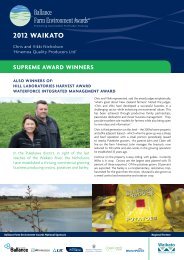Dairy's role in sustaining New Zealand - Fonterra
Dairy's role in sustaining New Zealand - Fonterra
Dairy's role in sustaining New Zealand - Fonterra
You also want an ePaper? Increase the reach of your titles
YUMPU automatically turns print PDFs into web optimized ePapers that Google loves.
4. Production growth over the last decade<br />
4.1 Headl<strong>in</strong>e results<br />
At the national level, the growth <strong>in</strong> the dairy sector over the last decade has resulted <strong>in</strong>:<br />
• <strong>New</strong> <strong>Zealand</strong>’s 2009 GDP <strong>in</strong>creas<strong>in</strong>g by $690 million, relative to what it would have been<br />
had the dairy sector stagnated at 1998/99 levels. While labour and land can switch to<br />
alternative uses should dairy have stagnated, productivity ga<strong>in</strong>s and capital accumulation<br />
with<strong>in</strong> the sector are net ga<strong>in</strong>s to the economy.<br />
• <strong>New</strong> <strong>Zealand</strong>’s 2009 welfare as proxied by private and public consumption be<strong>in</strong>g<br />
$1.1 billion higher than it would otherwise been. From the po<strong>in</strong>t of view of 1999, the<br />
cumulative net present value (NPV) of the decade’s consumption growth to 2009 is $6.4<br />
billion.<br />
• The dairy sector’s strong export growth over the last decade has improved <strong>New</strong> <strong>Zealand</strong>’s<br />
balance of trade, and allowed for <strong>in</strong>creased consumption spend<strong>in</strong>g. This export growth<br />
reduced <strong>New</strong> <strong>Zealand</strong>’s net foreign liabilities to GDP ratio by over 1%. Together with the<br />
exchange rate appreciation, this saved $231 million <strong>in</strong> <strong>in</strong>terest repayments on foreign<br />
debt <strong>in</strong> 2009, or cumulatively $1.2 billion from 1999.<br />
• Real wages <strong>in</strong> 2009 <strong>in</strong>creas<strong>in</strong>g by 0.9% as <strong>in</strong>creas<strong>in</strong>g <strong>in</strong>comes means <strong>in</strong>creased demand<br />
for goods and services, which <strong>in</strong> turn results <strong>in</strong> higher wages for employees.<br />
Significantly, the ga<strong>in</strong>s from the growth <strong>in</strong> the dairy sector, <strong>in</strong>clud<strong>in</strong>g wage rises, are not just<br />
felt with<strong>in</strong> the sector itself, but more widely throughout the economy:<br />
• Growth <strong>in</strong> the fertilizer and agricultural service <strong>in</strong>dustries, which supply the dairy sector<br />
with <strong>in</strong>termediate <strong>in</strong>puts, are up by 0.9% and 4.3% <strong>in</strong> 2009, relative to what they would<br />
have been if dairy stagnated.<br />
• Industries where households spend their <strong>in</strong>come, such as retail and hous<strong>in</strong>g, also benefit<br />
from the growth <strong>in</strong> the dairy sector, with activity <strong>in</strong> 2009 0.5% and 0.9% higher than had<br />
dairy not grown as experienced.<br />
• These positive flow-on impacts have further flow-on impacts to the tax-take of the<br />
government. Increased tax revenue com<strong>in</strong>g <strong>in</strong> means more money to spend on essential<br />
services such as schools, hospitals and police. In 2009, these sectors are 0.7%, 0.6% and<br />
0.2% better off because of the growth <strong>in</strong> the dairy sector.<br />
• Conversely, there are <strong>in</strong>dustries that have lost from growth <strong>in</strong> the dairy sector, most<br />
notably the sheep and beef sector which competes for resources. Our modell<strong>in</strong>g<br />
suggests that this <strong>in</strong>dustry would have grown by an extra 10% over the last decade,<br />
had dairy stagnated rather than grown. Similarly, other export <strong>in</strong>dustries such as textiles<br />
and apples and pears suffered from a higher exchange rate, down by -2.3% and -3.0%<br />
respectively.<br />
Regionally, the results favour those areas where dairy farm<strong>in</strong>g has grown the most:<br />
• Canterbury and Southland 2009 regional GDP levels are 1.4% and 1.3% higher than they<br />
would have been had dairy<strong>in</strong>g not <strong>in</strong>creased the economic activity with<strong>in</strong> their districts.<br />
• Hawkes Bay, with a strong dependence on fruit and horticulture, is 0.3% worse off<br />
because of the currency appreciation caused by the growth <strong>in</strong> dairy<strong>in</strong>g.<br />
Dairy’s <strong>role</strong> <strong>in</strong> generat<strong>in</strong>g growth<br />
19
















